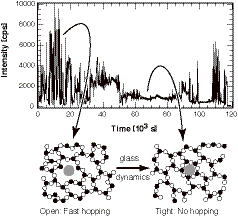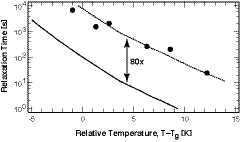
ACS PRF | ACS
All e-Annual Reports

42471-GB7
Non-Arrhenius Glass Dynamics at the Single Molecule Level
Introduction
From sugar coatings on corn flakes to plastics, glasses are ubiquitous materials in our world. Glasses, unlike solids are not static, they relax slowly leading to a gradual change of the mechanical properties of the material. Given the widespread use of these materials, this relaxation dynamics is therefore not just of fundamental but also of practical interest. Single molecule spectroscopy allows to observe microscopic processes in heterogeneous systems, such as glasses, which in traditional experiments are hidden behind the unavoidable averaging over a large number of molecules. <>Experiment
We continued our investigation using single Rhodamine B molecules in a matrix of poly (vinyl acetate). We extended our capabilities towards lower temperatures by incorporating a shutter in the experimental setup. This allows us to observe single molecules for an unprecedented duration of up to two days (Figure 1), which is essential for the observation of the slow dynamics below the glass transition temperature. We collected single molecule data at various temperatures at and below the glass transition temperature.
Figure 1: Observation of changes in the single molecule hopping rate indicative of rearrangements in the glass environment Results Improvements of our experimental approach now allows us to investigate glass dynamics at the single molecule level from 1K below the glass transition to 12K above the glass transition, consistent with results from (bulk) dielectric spectroscopy (Figure 2). Due to the size of the probe molecule, the time scale measured with our single experiments is 80x slower than that of the bulk experiments. Thanks to the molecular detail of our technique we are able to determine distributions of time scales, whose – in comparison to dielectric experiments – narrow width we interpret as time-averaging over exchanging heterogeneities (lines in Figure 3). We can determine an upper limit for the lifetime of individual heterogeneities as the average time between two observed glass rearrangement events, or 80-times slower than the bulk relaxation rate of the glass. Investigations with smaller probe molecules are under way to tighten this upper limit. Figure 2: Glass relaxation time as a function of temperature (points) in comparison to dielectric experiments (solid line). Figure 3: Narrowing of the distribution of relaxation times of individual heterogeneities due to "exchanges" of heterogeneities. 

